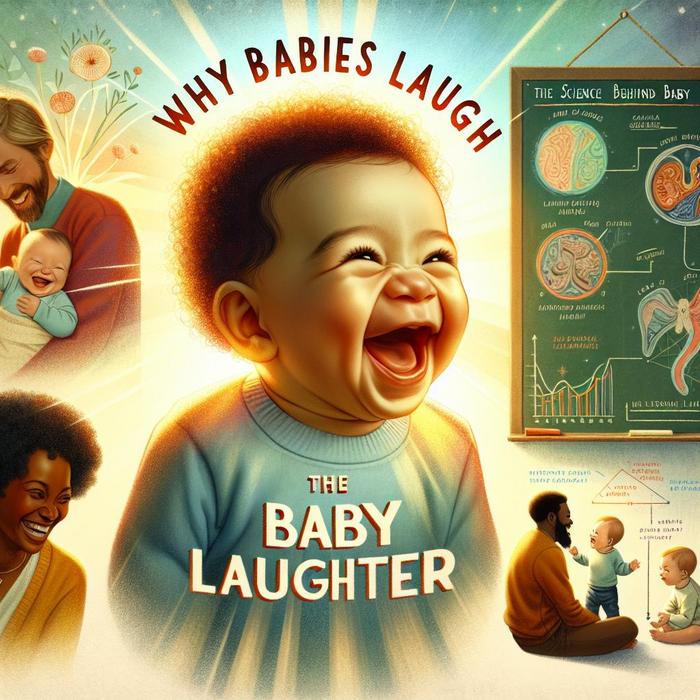The Fascinating Phenomenon of Baby Laughter
Baby laughter is one of those pure, delightful sounds that can instantly brighten anyone’s day. However, beyond its heartwarming appeal, it also holds a wealth of scientific intrigue. Why do babies laugh? What’s happening in their little brains when they produce these joyous sounds?
The Neuroscience Behind Baby Laughter
Unbeknownst to many, a baby’s laughter signals more than just a fleeting moment of joy. It’s a complex interplay of cognitive and emotional development. In fact, studying baby laughter has become a fascinating field for many scientists, such as Dr. Caspar Addyman, who studies baby laughter at Goldsmiths, University of London. You can find more about his work here.
A few key findings from his research include:
- A baby’s laughter begins at around three to four months old, coinciding with the development of major cognitive functions.
- The sound of baby laughter activates the brain’s reward system, releasing feel-good chemicals like endorphins and dopamine in listeners. This biologically ingrained response may have evolved to encourage caregivers to engage with and care for their babies.
- Babies laugh differently from adults. While adults primarily laugh during exhales, babies laugh during both inhales and exhales, much like primates. This suggests that laughter has deep evolutionary roots.
For more insights from Dr. Addyman’s research, you can visit his blog here.
Exploring the Emotional Aspect of Baby Laughter
Baby laughter isn’t just about cognitive development. It’s also an important emotional milestone, as explained in this article. Laughter is one of the first emotional responses a baby displays, marking the beginning of their emotional growth and their ability to communicate their feelings. Plus, it paves the way for their social and emotional bonds by fostering positive interactions with caregivers.
The emotional aspect of baby laughter also aligns with studies conducted by researchers at the British Psychological Society. They argue that babies truly enjoy being babies and their laughter reflects this joy. You can find more details on their research here.
Integrating Laughter Into Your Baby’s Routine
Given what we now know about the importance of baby laughter, it would be beneficial to embrace it as part of your baby’s daily routines. Start by incorporating fun, playful activities that are known to induce laughter, such as gentle tickling, mimicking their sounds, or playing peek-a-boo. Don’t worry if you’re unsure about how to get started, this article provides some helpful suggestions.
Ultimately, remember that every baby is unique, so what causes one baby to laugh might not work for another. The key is to stay patient, observant, and responsive to your baby’s individual responses.
As we continue delving into the science and psychology behind baby laughter, let’s also celebrate and embrace these joyful expressions for what they fundamentally are – an endearing part of our shared human experience.
The Origins of Baby Laughter
Experts like Dr. Addyman trace the origins of baby laughter back to our early ancestors. It’s believed that the foundations of laughter are rooted in the playful interactions between mother and child. Even apes and monkeys are known to engage in social laughter.
One key similarity between human and primate laughter lies in the breathing pattern. As mentioned earlier, babies often laugh during both inhales and exhales, like primates. This pattern changes as they grow older, aligning more with adult human laughter – primarily during exhales. For a detailed insight into primate laughter and its link to babies, here is a relevant research paper.
Further Research on Baby Laughter
Though significant strides have been made in understanding baby laughter, it continues to be a fascinating, complex phenomenon that captivates researchers worldwide. A lot is yet to be explored and explained.
– What’s the underlying science behind the contagious nature of laughter?
– How does baby laughter contribute to their language development?
– Why do babies laugh while sleeping?
For those interested in delving deeper into this subject, The Laughing Baby by Dr. Addyman is an excellent resource. Dr. Addyman’s pivotal research explores these questions and provides a comprehensive understanding of the intricate world of baby laughter.
The Importance of Encouraging Baby Laughter
Even as we strive to unravel the complexities of baby laughter, we should not lose sight of its immediate and most profound impact – the joy and connection it fosters. Encouraging baby laughter isn’t merely about achieving cognitive and emotional milestones. It’s about creating cherished moments of bonding and delight.
From a scientific perspective, laughing helps babies learn more about their world, form relationships, and reduce stress levels. From a caregiver’s angle, it’s a joyful bonding experience that helps establish a sense of security and unconditional love in the baby. Here’s an informative article shedding light on the matter.
Conclusion
In summary, baby laughter is an utterly unique blend of cognitive development, emotional expression, and evolutionary practice. It subtly encapsulates the tremendously complex processes of a baby’s developing brain while beautifully divulging the joy and wonder of being a baby. The more we learn, the more we can appreciate these precious moments of laughter and integrate them into our relationships with our babies.
So, as we develop a deeper understanding of the science behind baby laughter, let’s endeavour to fill our little ones’ days with laughter-filled moments. Let’s continue to marvel at the heart-melting sound of baby laughter and celebrate the sheer joy and delight it brings to our lives.






